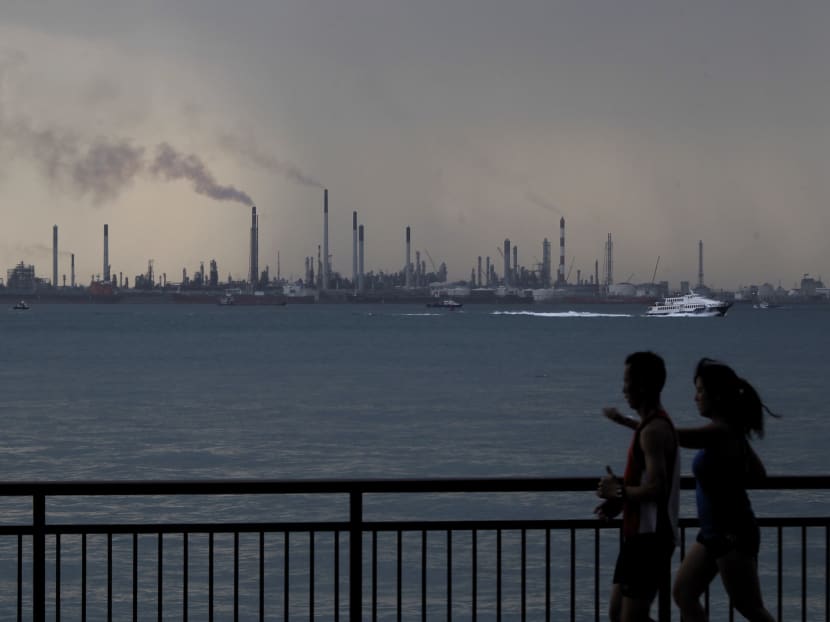Singapore cut carbon intensity by 30 per cent
SINGAPORE — The Republic has dramatically reduced its carbon intensity — or the amount of carbon dioxide emissions per dollar of gross domestic product — between 2000 and 2010, largely due to its switch from fuel oil to natural gas as the main energy source. Over that period, the carbon intensity fell by 30 per cent, compared to the global average decrease of only 0.12 per cent.
SINGAPORE — The Republic has dramatically reduced its carbon intensity — or the amount of carbon dioxide emissions per dollar of gross domestic product — between 2000 and 2010, largely due to its switch from fuel oil to natural gas as the main energy source. Over that period, the carbon intensity fell by 30 per cent, compared to the global average decrease of only 0.12 per cent.
The improvement was revealed by Minister for the Environment and Water Resources Vivian Balakrishnan, when he delivered the Republic’s national statement at the United Nations Climate Change Conference in Lima, Peru.
Between 2000 and 2010, Singapore’s total greenhouse gas emissions increased by about 21 per cent — to 46.83 million tonnes — while its GDP grew by about 76 per cent. Dr Balakrishnan noted that Singapore has been generating relatively low levels of carbon emissions per GDP dollar, ranking 113th out of 140 countries in the International Energy Agency 2014 Key World Energy Statistics report. “We contribute very little at aggregate level to global emissions but we will play our part,” he said.
Singapore has submitted its first Biennial Update Report — a summary of the country’s actions to mitigate climate change and its effects. The report noted that the Republic’s switch to a cleaner fuel mix was one of the key policy initiatives that led to the decrease in carbon intensity.
The proportion of Singapore’s electricity generated by natural gas – which has lower carbon content per unit of electricity generated – jumped from 26 per cent in 2001 to 84 per cent in 2012.
Other factors that helped lower carbon intensity levels include introducing various schemes that have promoted energy efficiency, such as the Green Mark Scheme - a benchmark for sustainable building practices - and a grant for owners and operators of industrial facilities to invest in energy efficient technologies.
Carbon intensity measures how efficient a country is in its use of fossil fuels such as fuel oil and natural gas.
The report said that the energy and transformation industries, which burn fossil fuels to generate electricity, contributed 46 per cent of the carbon dioxide emissions from fuel combustion in the energy sector in 2010, while industrial activities account for 38 per cent.
Experts hailed Singapore’s achievement in reducing carbon intensity but they noted that more can be done.
For example, Professor Rajasekhar Balasubramanian from the National University of Singapore cited how the public sector has been working towards decarbonisation by building greener buildings and looking at ways to convert waste into energy.
Nanyang Technological University economist Chang Youngho pointed out that efforts to further reduce carbon intensity may be costly. For instance, adopting energy efficient technology may lead to higher production costs, which could in turn affect economic growth.
Mr Kavickumar Muruganathan, Resident Engineer at the Singapore Environment Council, noted that the Grant for Energy Efficient Technologies has not been sufficiently tapped by the private sector since it was put in place in 2005. “More can be done to market these schemes... and get (firms) to switch to clean technology and renewable energy sources,” he said. Still, he said it will be harder to match the strides made in earlier years. “We might not be able to expect such a steep decrease in years to come, primarily due to the limitations in technology and nature,” he said, citing the example of solar energy which cannot yet fully replace natural gas as an energy source given existing technologies and the Republic’s environmental conditions.
At the conference, Dr Balakrishnan reaffirmed Singapore’s commitment to dealing with climate change issues, citing the recent launch of the Sustainable Singapore Blueprint 2015 as an example. The Republic has embarked on policies and measures that will reduce its emissions by 7 to 11 per cent below 2020 business-as-usual levels - estimated to be about 77.2 million tonnes.
The conference in Peru was aimed at laying the foundation for a new climate change agreement that will come into effect in 2020. The agreement has to be finalised at the UN Climate Change Conference in Paris next year.







